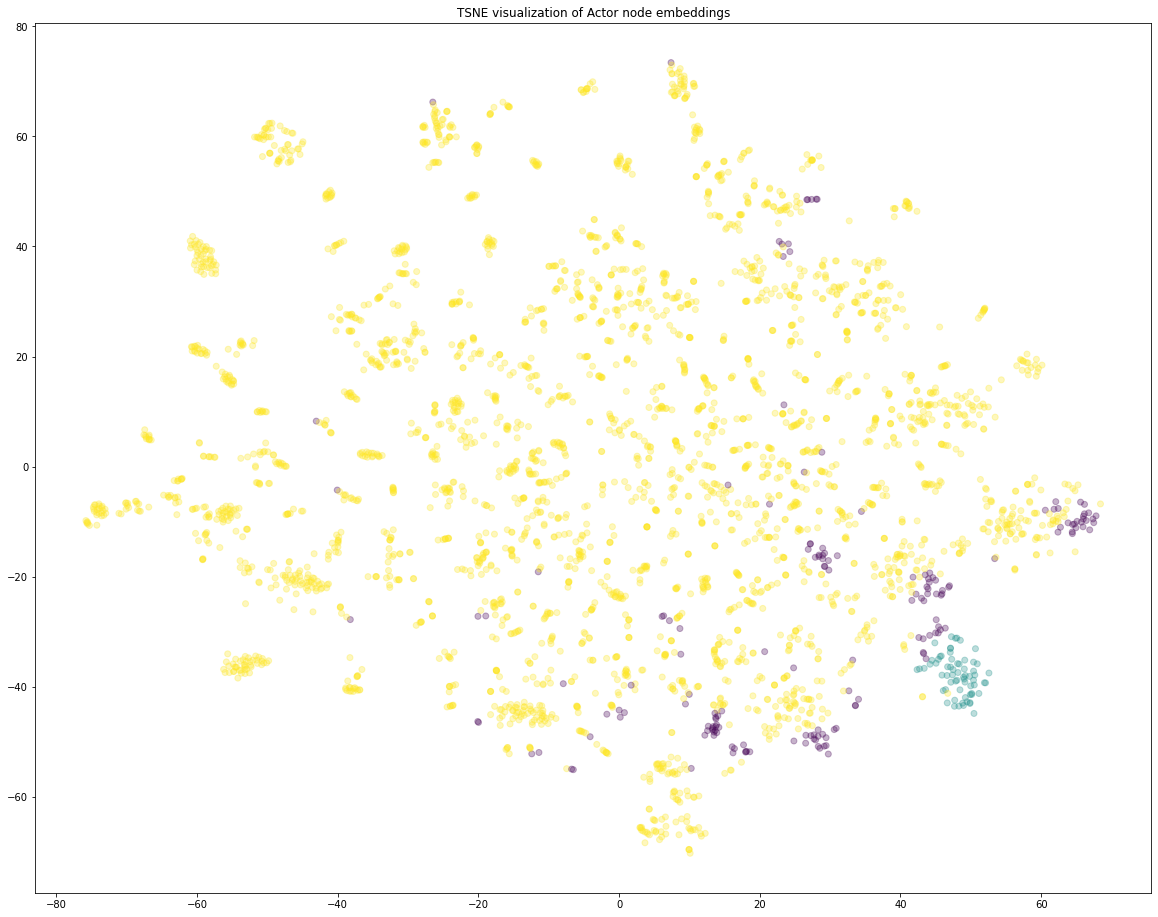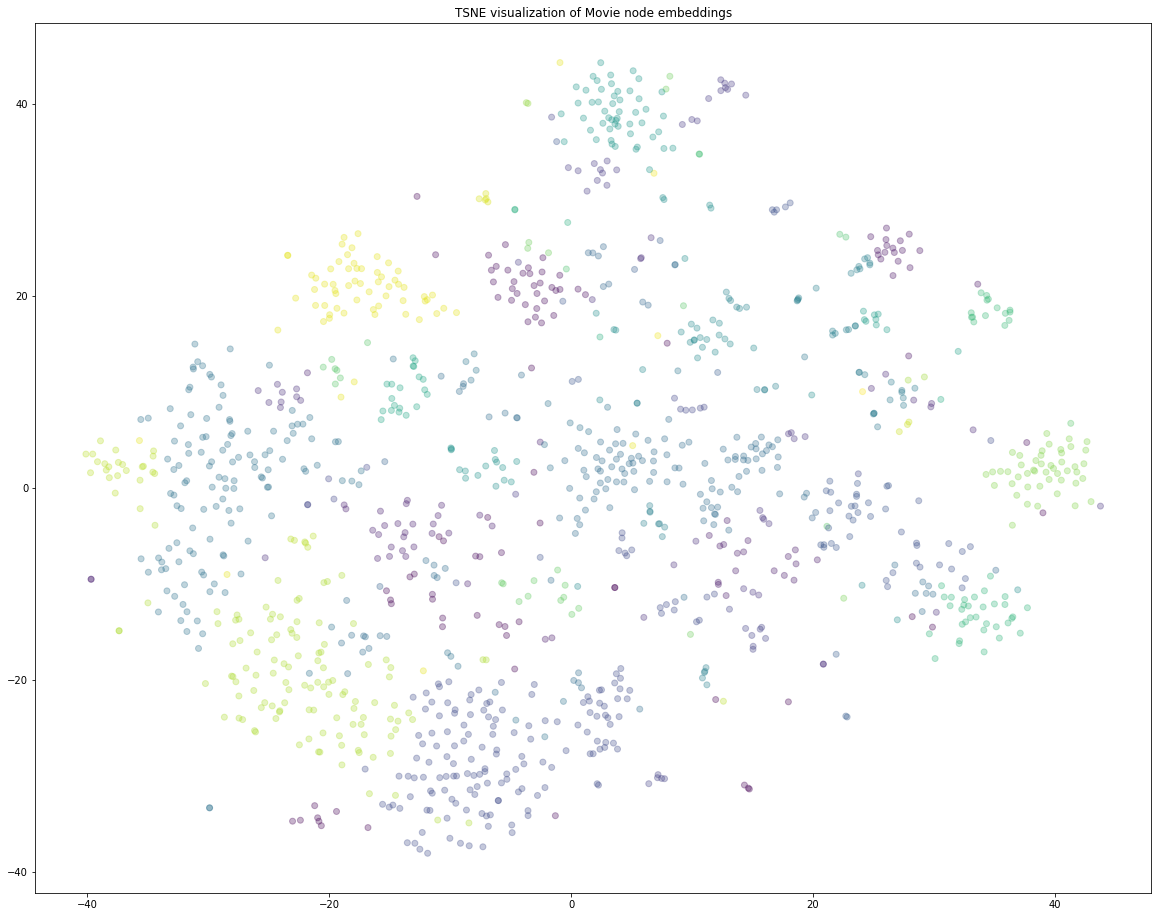- Given data of Actor and movies in which actor acted, We wanted to group similar movies together and group similar Actors together
- We will form this as a graph problem, We will build bipartite Graph from sets of actors and sets of movies, and use graph algorithms to form implicit embeddings for every node ( movies and actors )
- We will then user clustering methods to cluster similar movies and actors
-
Formulate problem as graph problem, we have two different sets of nodes. one for movies and second for actors, so we will use bipartite graph
-
Generate Node Embedding using Representation Learning
- We will use random walks to get embeddings for all the movies and actors, we will user metapath2Vec algorithm
The Metapath2Vec algorithm introduced in metapath2Vec is a 2-step representation learning algorithm. The two steps are:
-
Use uniform random walks to generate sentences from a graph. A sentence is a list of node IDs. The set of all sentences makes a corpus. The random walk is driven by a metapath that defines the node type order by which the random walker explores the graph.
-
The corpus is then used to learn an embedding vector for each node in the graph. Each node ID is considered a unique word/token in a dictionary that has size equal to the number of nodes in the graph. The Word2Vec algorithm is used for calculating the embedding vectors.
- Two possible Random Walk Model
- [ Movie, Actor, Movie ]
- [ Actor, Movie, Actor ]
- We will do 100 random walks and use randomwalks to generate embedding using genism
- Get all the actor nodes, and get actor embeddings
- Apply clustering algorithm like AgglomerativeClustering, and Kmeans
- Choose the number of clusters for which maximum score of $Cost1*Cost2$
- Cost1 =
where N= number of clusters
Cost 1 is maximize when all the actors are connected to each other, and they form largest connected component with dense graph.
Cost 2 is maximize when actors are connected to every other movies, more the actors are connected to more movies and more movies connected to more actors form a dense cluster. 6. Fit the clustering algorithm with the opimal number_of_clusters and get the cluster number for each node
7. Convert the d-dimensional dense vectors of nodes into 2-dimensional using dimensionality reduction techniques ( TSNE)
8. Plot the 2d scatter plot, with the node vectors after step 7 and give colors to nodes such that same cluster nodes will have same color
for number_of_clusters in [3, 5, 10, 30, 50, 100, 200, 500]:
algo = clustering_algorith(clusters=number_of_clusters)
# you will be passing a matrix of size N*d
# where N number of actor nodes and d is dimension from gensim
algo.fit(the dense vectors of actor nodes)
#You can get the labels for corresponding actor nodes (algo.labels_)
#Create a graph for every cluster(ie., if n_clusters=3, create 3 graphs)
(You can use ego_graph to create subgraph from the actual graph)
compute cost1,cost2
(if n_cluster=3, cost1=cost1(graph1)+cost1(graph2)+cost1(graph3) # here we are doing summation
cost2=cost2(graph1)+cost2(graph2)+cost2(graph3)
computer the metric Cost = Cost1*Cost2
return number_of_clusters which have maximum Cost
| Clustering Method | no of cluster | cost |
|---|---|---|
| AgglomerativeClustering | 3 | 3.921742357 |
| KMeans | 3 | 3.696554334 |
| AgglomerativeClustering | 5 | 2.900189835 |
| KMeans | 5 | 2.884047912 |
| KMeans | 7 | 2.583752254 |
| AgglomerativeClustering | 7 | 2.541207708 |
| AgglomerativeClustering | 10 | 2.246406932 |
| KMeans | 10 | 2.20472405 |
| AgglomerativeClustering | 20 | 2.128346378 |
| AgglomerativeClustering | 200 | 2.116761654 |
| AgglomerativeClustering | 15 | 2.106809976 |
| AgglomerativeClustering | 500 | 2.101435191 |
| AgglomerativeClustering | 25 | 2.00551537 |
| KMeans | 15 | 1.977317111 |
| AgglomerativeClustering | 30 | 1.890698712 |
| KMeans | 500 | 1.885944087 |
| KMeans | 20 | 1.864328479 |
| KMeans | 200 | 1.767619081 |
| KMeans | 30 | 1.758672095 |
| KMeans | 25 | 1.720282174 |
| AgglomerativeClustering | 50 | 1.60247998 |
| AgglomerativeClustering | 100 | 1.595304077 |
| KMeans | 50 | 1.517051723 |
| KMeans | 100 | 1.449046075 |
- Get all the movie nodes, and get movie embeddings
- Apply clustering algorithm like AgglomerativeClustering, and Kmeans
- Choose the number of clusters for which maximum score of $Cost1*Cost2$
- Cost1 =
where N= number of clusters
) where N= number of clusters - Cost2 =
where N= number of clusters
6. Fit the clustering algorithm with the opimal number_of_clusters and get the cluster number for each node
7. Convert the d-dimensional dense vectors of nodes into 2-dimensional using dimensionality reduction techniques ( TSNE)
8. Plot the 2d scatter plot, with the node vectors after step 7 and give colors to nodes such that same cluster nodes will have same color
| Clustering Method | no of cluster | cost |
|---|---|---|
| AgglomerativeClustering | 50 | 14.30479542 |
| KMeans | 100 | 13.91774692 |
| AgglomerativeClustering | 100 | 13.557715 |
| KMeans | 30 | 13.4977687 |
| KMeans | 50 | 13.07082445 |
| KMeans | 200 | 12.72019123 |
| AgglomerativeClustering | 30 | 12.52828938 |
| AgglomerativeClustering | 200 | 12.41167839 |
| KMeans | 25 | 11.37323168 |
| KMeans | 15 | 11.03547218 |
| AgglomerativeClustering | 20 | 10.89731702 |
| KMeans | 20 | 10.83971441 |
| AgglomerativeClustering | 5 | 10.81933152 |
| AgglomerativeClustering | 25 | 10.62964062 |
| KMeans | 500 | 10.38436946 |
| AgglomerativeClustering | 500 | 10.30178991 |
| KMeans | 7 | 9.626998928 |
| AgglomerativeClustering | 7 | 9.53589177 |
| KMeans | 10 | 9.300160366 |
| AgglomerativeClustering | 3 | 9.299485713 |
| AgglomerativeClustering | 15 | 8.905799924 |
| AgglomerativeClustering | 10 | 8.880725213 |
| KMeans | 5 | 8.601141307 |
| KMeans | 3 | 8.356465399 |

